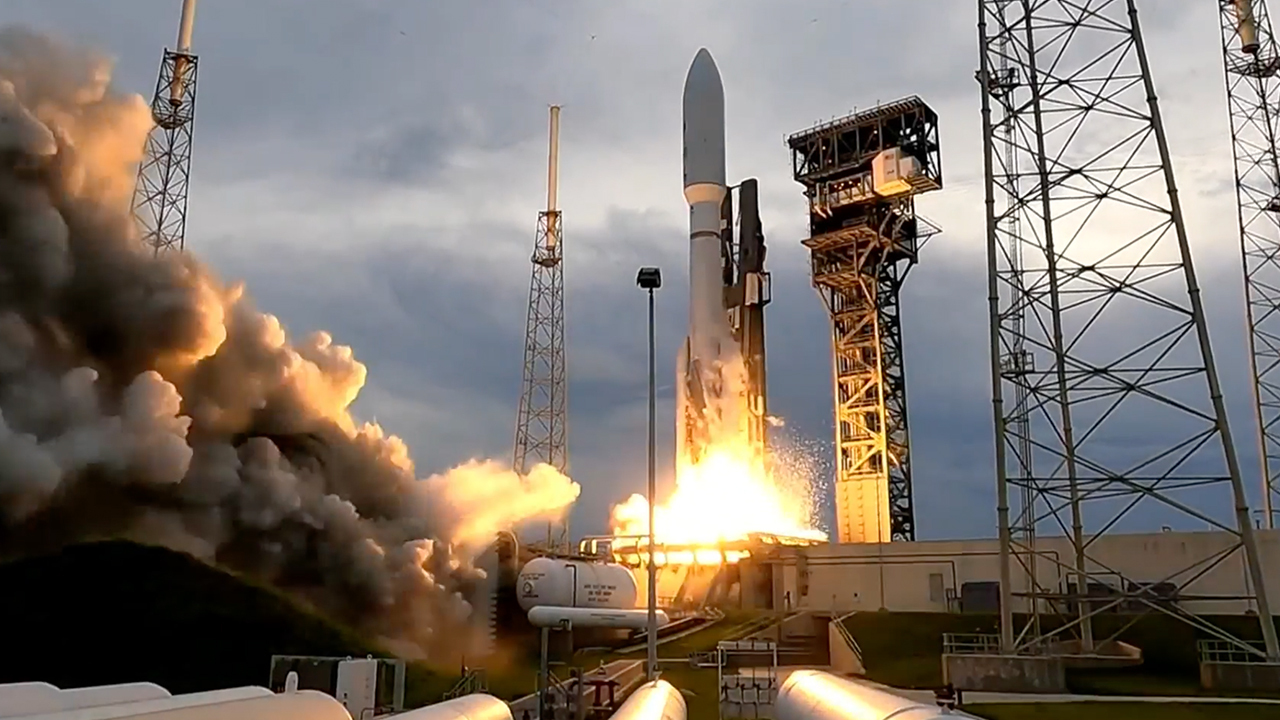Atlas V rocket launches classified missile-tracking satellite for US Space Force
A pair of surveillance satellites are headed to orbit to help make sure you don't get hypersonic-missiled in your sleep.
A missile-warning satellite and another spacecraft are on their way to orbit to help the U.S. military get better at tracking fast-moving threats.
The two U.S. military surveillance satellites lifted off today (July 1) atop a United Launch Alliance (ULA) Atlas V rocket, which rose off a pad at Florida's Cape Canaveral Space Force Station at 7:15 p.m. EDT (2315 GMT) on a mission for the U.S. Space Force called USSF-12.
The Atlas V's first and second stages separated four and a half minutes after liftoff, a milestone that was soon followed by a more than six-minute burn of the upper-stage Centaur's engine. After two more Centaur burns, the two satellites were ready to be deployed into geosynchronous orbit, about 22,300 miles (35,900 kilometers) above Earth. That happened as planned about six hours after liftoff, ULA representatives said via Twitter early Saturday morning.
Related: The most dangerous space weapons ever

One of the two spacecraft, called the Wide Field of View (WFOV) satellite, is the Space Force Space System Command's (SSC) testing platform for a new generation of missile-surveillance technology. The other is a satellite bus hosting a number of technology demonstrations for the U.S. Department of Defense (DoD). It is called, simply, the USSF-12 Ring.
Both WFOV and the USSF-12 Ring are considered classified payloads in support of national security, so not much information is available for either of them. However, government agency and contractor representatives were able to provide some details during a call with reporters on Tuesday (June 28).
The USSF-12 Ring was built by Northrop Grumman based on the aerospace company's ESPAStar product line. This ring is being flown for the DoD and features six unique payload ports as well as an independent propulsion system, Matt Verock, vice president of space security for Northrop Grumman, said during the call.
Get the Space.com Newsletter
Breaking space news, the latest updates on rocket launches, skywatching events and more!
The DoD has not disclosed details regarding any of those payloads, but DoD space test program director Lt. Col. Jon Shea said that the USSF-12 Ring and its payloads "will deploy key pathfinders for future capabilities and deliver innovative technologies to help us advance … future missions."
WFOV has an imaging sensor that's more than 6 feet tall (about 2 meters). The sensor was built by L3Harris Technologies, a company that also supplied optical components for NASA's Hubble and James Webb space telescopes, as well as the Nancy Grace Roman space telescope, which is currently in development. The sensor was designed for a new type of weapons detection system — the tracking of hypersonic weapons — and WFOV will help SSC calibrate its accuracy.
Russian state media announced a successful test of the country's new hypersonic Kinzhal missile in 2018 and published an animated video of the missile being fired at the United States. The Kinzhal missile is reportedly able to travel five times faster than the speed of sound and capable of striking targets anywhere in the world.
Current space-deployed weapons tracking systems focus on ballistic missiles, which have limited maneuverability. The DoD has created a new system, the Overhead Persistent Infrared program (OPIR), to track next-generation hypersonic threats, such as the Kinzhal. WFOV is the testbed for those technologies.
"The threat is imminent right now," Col. Heather Bogstie, senior materiel leader for the SSC's Resilient Missile Warning, Tracking and Defense Acquisition Delta, said during Tuesday's call. "[WFOV] is really going to be an important pathfinder for our future MEO [middle Earth orbit] missile track systems."
She described the WFOV mission as a "digital engineering demo," which will give "24/7 coverage across 3,000+ kilometers [1,860 miles] over the Pacific Theater."
The WFOV satellite and USSF-12 Ring are designed for mission operability for up to three years. WFOV's successors, the OPIR program satellites, are on track to begin launching as soon as 2025, according to an SSC release, with a total of five slated to launch between then and 2028.
Editor's note: This story was updated at 2:45 a.m. EDT on July 2 with news of successful satellite deploy.
Follow us on Twitter @Spacedotcom or on Facebook.
Join our Space Forums to keep talking space on the latest missions, night sky and more! And if you have a news tip, correction or comment, let us know at: community@space.com.

Josh Dinner is the Staff Writer for Spaceflight at Space.com. He is a writer and photographer with a passion for science and space exploration, and has been working the space beat since 2016. Josh has covered the evolution of NASA's commercial spaceflight partnerships and crewed missions from the Space Coast, as well as NASA science missions and more. He also enjoys building 1:144-scale model rockets and human-flown spacecraft. Find some of Josh's launch photography on Instagram and his website, and follow him on X, where he mostly posts in haiku.









